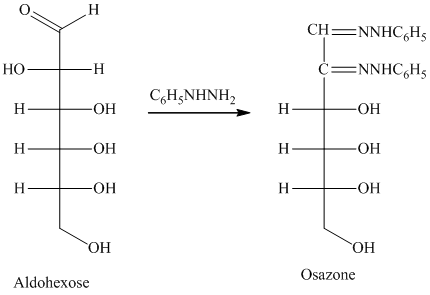
Concept explainers
Interpretation:
The distinguishing tests for the pair of given compounds are to be determined.
Concept introduction:
舧 Chair conformations: It is the most stable conformation, which accurately shows the spatial arrangement of atoms.
舧 Equatorial bonds are parallel to the average plane of the ring, while axial bonds are perpendicular to the average plane of the ring.
舧 The conformation having bonds at the equatorial positions are more stable than those with bonds at the axial position.
舧 On flipping the cyclohexane ring, axial bonds become equatorial bonds and equatorial bonds becomes axial bond.
舧 Bulkier group acquires equatorial positions to form stable conformer due to steric factors.
舧 The most stable configuration of aldopyranoses is when the
舧 Stereochemistry: The equatorial orientation refers to the spatial arrangement of
舧 The anomeric effect is lowest for sugars with equatorial orientation, which results in lower energetic state, and consequently this type of orientation confers higher stability.
舧 The anomeric effect is highest for sugars with axial orientation, which results in higher energetic state, and consequently this type of orientation confers lower stability.
舧 A carbohydrate is a
舧
舧 Carbohydrates are oxidized by
舧 Aldaric acids are carbohydrates having two carboxylic acids. They are formed due to oxidation reaction of aldoses with dilute

舧 Monosaccharides containing six carbon atoms and an aldehyde group are called aldohexoses.
舧 Alditols are compounds produced from aldoses or ketoses on reduction with certain reagents such as sodium borohydride (
舧 
舧 Compounds formed by the reaction of reducing sugars with excess of phenyl hydrazine are called osazones. Osazones are products of oxidation and are produced by all reducing sugars.
舧 
舧 Fischer projection is a way of representing the structural formulae of compounds through cross formulation of their open chain structures.
舧. Bromine water is an effective reagent that selectively oxidizes the
舧 
Tollen’s (
舧 Compounds that have plane of symmetry tend to form meso compounds. A meso form arises when the two stereoisomers produce superimposable (achiral) images, and hence, compounds having meso are optically inactive. Chiral (or non-superimposable) molecules are optically active.
舧
Want to see the full answer?
Check out a sample textbook solution
Chapter 22 Solutions
Organic Chemistry
- Which statement about saccharides is correct? (A). Alpha anomers are more common than beta anoomers. (B). Two monosaccharides can form a disaccharide and oxygen. (C). Polysaccharides with alpha or beta glycosidic linkages have the different properties. (D). Disaccharides can be cyclic or acyclic.arrow_forwardDraw the structure and give the systematic name of the given disaccharides. [No need to show the stepwise process] (a) Lactose which is also known as milk sugar: β-D-Gal(1à4)β-D-Glc, where Gal is galactose and Glc is glucose.arrow_forwardWhat glycosides are formed when each monosaccharide is treated with CH3CH2OH, HCl: (a) β-D-mannose; (b) α-D-gulose; (c) β-D-fructose?arrow_forward
- Explain the meaning of the following: (a) Chiral carbon (b) Enantiomers (c) Esterificationarrow_forward(i) Which one of the following is a polysaccharide :Starch, Maltose, Fructose, Glucose?(ii) What one difference between a-helix and P-pleated sheet structure of protein.(iii) Write the name of the disease caused by the deficiency of Vitamin B12.arrow_forwardIndicate whether each statement is true or false: (a)Disaccharides are a type of carbohydrate. (b) Sucrose is amonosaccharide. (c) All carbohydrates have the formulaCnH2mOm.arrow_forward
- In glycoside formation, the hemiacetal functional group of a cyclic monosaccharide is converted to an acetal group by reaction with a(an)arrow_forward(i) Which one of the following is a disaccharide : Starch, Maltose, Fructose, Glucose?(ii) What is the difference between fibrous protein and globular protein?(iii) Write the name of vitamin whose deficiency causes bones deformities in children.arrow_forwardConsider N-acetyl-d-glucosamine Q.) Draw a chair conformation for the disaccharide formed by joining two units of the pyranose form of N-acetyl-d-glucosamine by a b-1,4-glycosidic bond. If you draw this correctly, you have the structural formula for the repeating dimer of chitin, the structural polysaccharide component of the shell of lobsters and other crustaceans.arrow_forward
 Chemistry for Today: General, Organic, and Bioche...ChemistryISBN:9781305960060Author:Spencer L. Seager, Michael R. Slabaugh, Maren S. HansenPublisher:Cengage Learning
Chemistry for Today: General, Organic, and Bioche...ChemistryISBN:9781305960060Author:Spencer L. Seager, Michael R. Slabaugh, Maren S. HansenPublisher:Cengage Learning Organic ChemistryChemistryISBN:9781305580350Author:William H. Brown, Brent L. Iverson, Eric Anslyn, Christopher S. FootePublisher:Cengage Learning
Organic ChemistryChemistryISBN:9781305580350Author:William H. Brown, Brent L. Iverson, Eric Anslyn, Christopher S. FootePublisher:Cengage Learning
 General, Organic, and Biological ChemistryChemistryISBN:9781285853918Author:H. Stephen StokerPublisher:Cengage Learning
General, Organic, and Biological ChemistryChemistryISBN:9781285853918Author:H. Stephen StokerPublisher:Cengage Learning Organic And Biological ChemistryChemistryISBN:9781305081079Author:STOKER, H. Stephen (howard Stephen)Publisher:Cengage Learning,
Organic And Biological ChemistryChemistryISBN:9781305081079Author:STOKER, H. Stephen (howard Stephen)Publisher:Cengage Learning,




